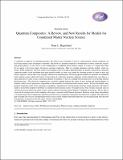Notice
This is not the latest version of this item. The latest version can be found at:https://dspace.mit.edu/handle/1721.1/122630.2
Quantum Composites: A Review, and New Results for Models for Condensed Matter Nuclear Science
| dc.date.accessioned | 2019-10-18T16:34:57Z | |
| dc.date.available | 2019-10-18T16:34:57Z | |
| dc.date.issued | 2016 | |
| dc.identifier.issn | 2227-3123 | |
| dc.identifier.uri | https://hdl.handle.net/1721.1/122630 | |
| dc.description.abstract | A composite is made up of constituent particles; the center of mass dynamics is that of a single particle, and the composite can have many internal states and degrees of freedom. The notion of a quantum composite is foundational to atomic, molecular, nuclear and particle physics; in our view it is also foundational to condensed matter nuclear science. It comes as a surprise that there do not appear to be review papers that discuss quantum composites. Here we consider elementary particles models, which are used to model composites; the most widely used example is that of the Dirac phenomenology for protons and neutrons. Quantum composite models can be developed from many-particle models, in some cases simply by rewriting in terms of center of mass and relative operators, and in other cases through a reduction or transformation. We have proposed models for anomalies in condensed matter nuclear science which rely heavily on the notion of a relativistic quantum composite. In the nonrelativistic case there is a clean separation of center of mass and internal degrees of freedom, so that any coupling between them must occur through external field interactions. The relativistic composite has a sizeable coupling between the center of mass motion and internal degrees of freedom, which we have proposed is responsible for the anomalies in condensed matter nuclear science. We have developed a new model in which the center of mass dynamics is modeled as nonrelativistic, but the internal structure is kept relativistic; this kind of model is much better adapted to problems in condensed matter nuclear science. Our approach has been strongly criticized, since in a Poincaré invariant theory the center of mass motion separates from the internal degrees of freedom in free space. We are able to rotate out the strongest part of this coupling in free space, consistent with Poincaré invariance. However, in the lattice the problem is in general much more complicated, and more powerful tools are required to diagonalize this relativistic coupling. The spin-boson type of models that we have considered previously for this are the simplest idealized models that can be diagonalized; they describe rich dynamics not present in the free-space version of the problem. Keywords: Center of mass; Foldy-Wouthuysen transformation; Phonon-nuclear coupling; Quantum composite | en_US |
| dc.publisher | International Society of Condensed Matter Nuclear Scientists (ISCMNS) | en_US |
| dc.relation.isversionof | www.iscmns.org/CMNS/JCMNS-Vol20.pdf | en_US |
| dc.rights | Article is made available in accordance with the publisher's policy and may be subject to US copyright law. Please refer to the publisher's site for terms of use. | en_US |
| dc.source | Prof. Hagelstein | en_US |
| dc.title | Quantum Composites: A Review, and New Results for Models for Condensed Matter Nuclear Science | en_US |
| dc.type | Article | en_US |
| dc.identifier.citation | Hagelstein, Peter L. "Quantum Composites: A Review, and New Results for Models for Condensed Matter Nuclear Science." Journal of Condensed Matter Nuclear Science 20 (2016): 139-225 © 2016 ISCMNS | en_US |
| dc.contributor.department | Massachusetts Institute of Technology. Department of Electrical Engineering and Computer Science | en_US |
| dc.relation.journal | Journal of Condensed Matter Nuclear Science | en_US |
| dc.eprint.version | Final published version | en_US |
| dc.type.uri | http://purl.org/eprint/type/JournalArticle | en_US |
| eprint.status | http://purl.org/eprint/status/PeerReviewed | en_US |
| dspace.date.submission | 2019-10-10T15:20:04Z | |
| mit.journal.volume | 20 | en_US |
| mit.license | OPEN_ACCESS_POLICY |
